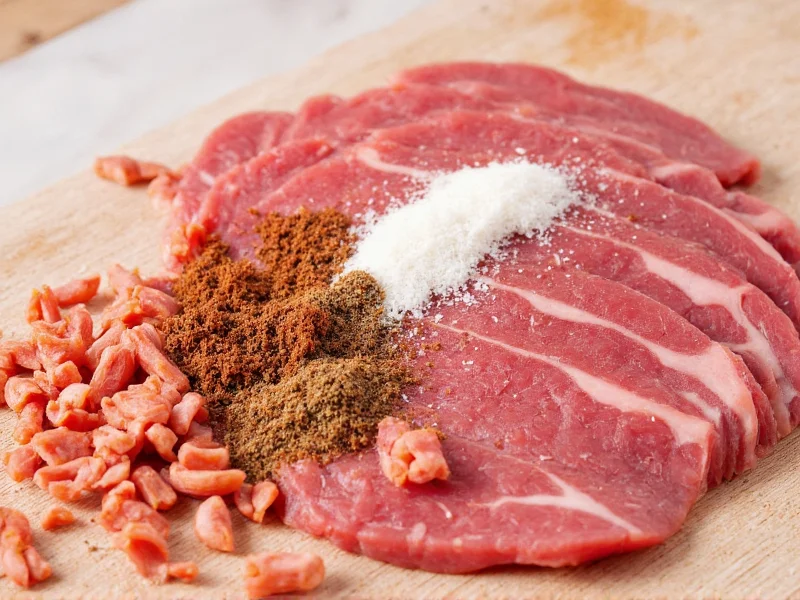Perfectly seasoned corned beef transforms from a simple cured meat into a flavorful centerpiece for any meal. Understanding which spices complement corned beef's rich, salty profile is essential for home cooks seeking authentic results. This guide details not just which spices work best, but why they matter and how to use them effectively for optimal flavor development.
The Foundation of Traditional Corned Beef Seasoning
Corned beef's distinctive flavor comes from both the curing process and the cooking spices. While commercial corned beef often includes a pre-packaged spice mix, creating your own blend allows for customization and superior freshness. The traditional spice combination works because each component contributes specific flavor notes that balance the meat's saltiness while enhancing its natural richness.
Essential Spices and Their Flavor Contributions
Understanding each spice's role helps you adjust proportions based on personal preference while maintaining authentic flavor balance. Whole spices generally provide cleaner, more nuanced flavors than pre-ground versions when simmered for extended periods.
| Spice | Flavor Profile | Recommended Quantity (per 3-4 lb brisket) | When to Add |
|---|---|---|---|
| Mustard seeds | Earthy, slightly pungent, nutty | 1-2 tablespoons | With cooking liquid at start |
| Coriander seeds | Citrusy, floral, slightly sweet | 1-2 tablespoons | With cooking liquid at start |
| Black peppercorns | Sharp, woody, mildly hot | 1-2 tablespoons | With cooking liquid at start |
| Allspice berries | Complex blend of cinnamon, nutmeg, clove | 1-2 teaspoons | With cooking liquid at start |
| Cloves | Intensely aromatic, sweet-spicy | 4-6 whole cloves | With cooking liquid at start |
| Bay leaves | Subtle herbal, slightly floral | 2-3 leaves | With cooking liquid at start |
| Crushed red pepper | Mild heat, subtle fruitiness | 1/2-1 teaspoon | Last 30 minutes of cooking |
Why Whole Spices Outperform Pre-Ground for Corned Beef
Using whole spices rather than pre-ground versions makes a significant difference in corned beef preparation. Whole spices maintain their essential oils and volatile compounds much longer, releasing flavors gradually during the extended cooking process. When you use pre-ground spices, they often become bitter or lose complexity when simmered for the 3-4 hours required for proper corned beef preparation. Toasting whole spices briefly in a dry pan before adding them to your cooking liquid enhances their aromatic compounds, creating a more robust flavor foundation.
Regional Variations and Creative Twists
While the traditional Irish-American corned beef spice blend remains popular, various culinary traditions offer interesting alternatives:
- New England style: Adds a touch of brown sugar and extra mustard seeds for subtle sweetness
- Montreal-style: Incorporates more black pepper and coriander with a hint of paprika
- Spicy Texas variation: Includes cumin, chili powder, and additional red pepper flakes
- Asian fusion: Small amounts of star anise and Szechuan peppercorns complement traditional spices
When experimenting with variations, maintain the core spice ratio (mustard, coriander, pepper) while introducing one or two additional elements. This approach ensures recognizable corned beef flavor while adding your personal touch.
Timing Matters: When to Add Different Spices
The timing of spice addition significantly impacts final flavor. Hard spices like seeds and berries should go in at the beginning of cooking to allow their flavors to fully infuse the broth. More delicate spices like crushed red pepper should be added during the last 30 minutes to preserve their brighter notes. Adding all spices at once results in some becoming overpowering while others disappear completely. For best results, consider using a spice bag or cheesecloth pouch that can be removed at appropriate intervals during cooking.
Avoiding Common Corned Beef Seasoning Mistakes
Even experienced cooks make these seasoning errors with corned beef:
- Overlooking the salt content: Remember that corned beef is already cured, so additional salt is rarely needed
- Using pre-ground spices: Results in muddy, bitter flavors after prolonged cooking
- Adding all spices at the end: Doesn't allow sufficient time for flavors to develop and penetrate the meat
- Ignoring acid balance: A splash of apple cider vinegar or beer added near the end brightens heavy spice notes
- Skipping the bloom step: Briefly toasting whole spices before use enhances their aromatic compounds
Creating Your Perfect Custom Blend
The ideal spice ratio depends on personal preference and cooking method. For stovetop preparation, use slightly more robust spices as some flavor dissipates through evaporation. For slow cooker or oven methods, reduce quantities by about 25% since flavors concentrate with contained moisture. Always taste your cooking liquid after the first hour and adjust spices as needed—remember that flavors continue developing throughout the cooking process. Store any unused spice blend in an airtight container away from light for up to six months.
Complementary Ingredients That Enhance Spice Profiles
Certain vegetables and liquids work synergistically with your spice blend:
- Onions: Yellow onions provide sweetness that balances spicy elements
- Garlic: Adds depth without overpowering traditional flavors
- Beets: Traditional in some recipes, they add earthiness that complements warm spices
- Beer: Guinness or other stouts enhance malty notes in the spice blend
- Vinegar: A small amount brightens heavy spice notes and helps tenderize the meat











 浙公网安备
33010002000092号
浙公网安备
33010002000092号 浙B2-20120091-4
浙B2-20120091-4